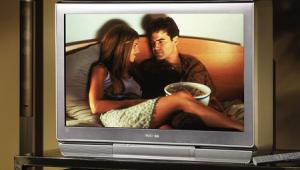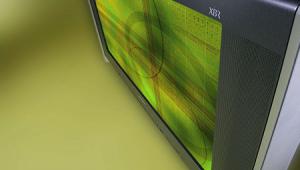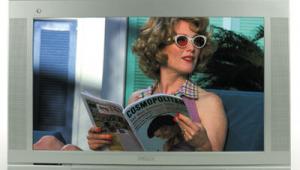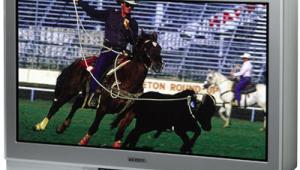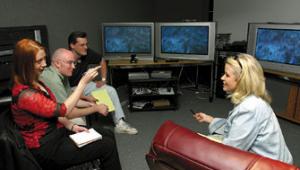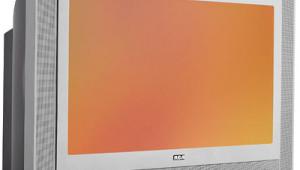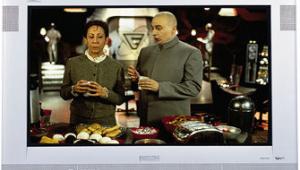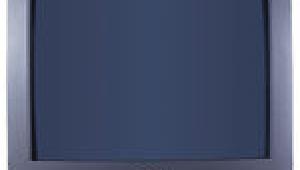The 2002 Direct-View HDTV Face Off Zenith C34W23
Zenith's entry into our Face Off was a bit of a dark horse. In the past, the company has put forth displays that could be made extremely accurate, thus catering to our presumably inherent bias. Unfortunately, this one couldn't. That and a few other attributes suggested that the display might take a serious beating in this month's Ultimate HDTV Fighting Championship. It didn't. Go figure.
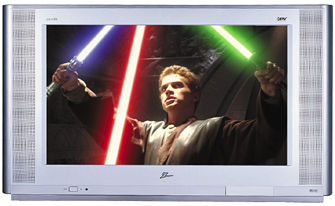
For starters, the C34W23 has a minimal, albeit adequate, number of inputs and should accommodate a basic home theater setup. Of the two component (Y/Pb/Pr) inputs, one accepts 480i DVD signals, and the other handles 1080i HDTV signals. Since the display has a built-in digital tuner, you may need one less input than you would with other TVs. Then again, you may not be able to get terrestrial broadcasts in your area. Regardless, neither one of these inputs accepts a progressive-scan DVD player's or external line doubler's 480p signal. This is too bad, particularly since the display's internal line doubler seems to lack 3:2-pulldown detection. You also won't find a digital video connection (DVI or IEEE 1394), which may be useful, if not necessary, with future digital satellite and cable tuners. The internal digital tuner accepts HDTV signals transmitted through some cable systems (8VSB), although you should check with your local provider to see what they use. You'll also find an optical digital audio output, which will send an HDTV channel's Dolby Digital soundtrack to your external receiver or processor.
 The menu is a bit more competitive than the back panel, using attractive graphics in a clean, well-laid-out structure. Unfortunately, much of the menu stays onscreen when you try to make adjustments, and some of the navigation is less than intuitive. My biggest gripe was that you can't save different picture settings for the individual inputs. Every time I changed inputs from DVD to antenna to HDTV, I had to readjust the picture.
The menu is a bit more competitive than the back panel, using attractive graphics in a clean, well-laid-out structure. Unfortunately, much of the menu stays onscreen when you try to make adjustments, and some of the navigation is less than intuitive. My biggest gripe was that you can't save different picture settings for the individual inputs. Every time I changed inputs from DVD to antenna to HDTV, I had to readjust the picture.
The remote didn't do anything to win friends, either. As Geoffrey pointed out, it's the same remote that comes with Zenith's C27V22 27-inch display (see his review in the October 2002 issue). So, either the 27-inch display has an expensive remote, or this TV has a cheap one. Maureen just thought it was too clunky. Claire didn't mind the small arrow functions, but she has smaller fingers than yours truly. As such, I had more trouble with it than she did and particularly didn't like the lack of backlighting. At least the remote offers some glow-in-the-dark buttons. I also liked the close proximity of the channel up/down and volume up/down buttons.
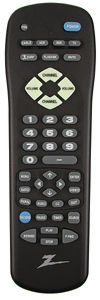 As I was setting up the display, I found a few attributes that will make the picture more pleasing to most people, but possibly less interesting to purists. For one, the set's DC restoration floats. In other words, the TV's black level changes depending on a scene's overall brightness. This changing black level makes darker scenes more visible in a bright room. In a dark room, Ron noted that it makes the image look a bit washed-out, and the changing level can be mildly distracting. Fortunately, a good service technician can eliminate this, assuming that it bothers you. Unfortunately, the same technician won't be able to adjust the display's color decoder, which, when properly adjusted, tends to exaggerate red or partially red images. When you view the TV using its factory settings, this extra red compensates for the image's overall blue tint. With the picture set for the lower color temperature, the extra red made Ethan Hawke's face in Training Day look like it was sunburned. I had to lower the color control significantly to make the image more natural-looking. As a result, Maureen noticed that other colors, like a diner's jacket from the same movie's opening scene, were less vibrant than they were on the other sets.
As I was setting up the display, I found a few attributes that will make the picture more pleasing to most people, but possibly less interesting to purists. For one, the set's DC restoration floats. In other words, the TV's black level changes depending on a scene's overall brightness. This changing black level makes darker scenes more visible in a bright room. In a dark room, Ron noted that it makes the image look a bit washed-out, and the changing level can be mildly distracting. Fortunately, a good service technician can eliminate this, assuming that it bothers you. Unfortunately, the same technician won't be able to adjust the display's color decoder, which, when properly adjusted, tends to exaggerate red or partially red images. When you view the TV using its factory settings, this extra red compensates for the image's overall blue tint. With the picture set for the lower color temperature, the extra red made Ethan Hawke's face in Training Day look like it was sunburned. I had to lower the color control significantly to make the image more natural-looking. As a result, Maureen noticed that other colors, like a diner's jacket from the same movie's opening scene, were less vibrant than they were on the other sets.
You won't need a service tech to turn the SVM on or off, as the control is in the user menu. This is handy because, although it obscures finer detail, SVM can create an apparent increase in midlevel details. To some extent, the set does this on its own, without SVM. The display's resolution capability seems to roll off rather quickly at higher frequencies (aka finer details). Claire pointed out that some images, like the vinyl-covered diner seat in Training Day, were more detailed on the Zenith TV, although finer details, like the characters' hair, were more distinguishable on the Philips. Overall, though, everyone agreed that the Zenith's picture was softer and less detailed than those of the other displays.
This didn't seem to bother anyone, though. In fact, most people seemed inexplicably attracted to the display's overall color balance. Without service adjustment, the Zenith's gray scale tracks reasonably well, although not substantially better than the other displays. After calibration, the picture measured expectedly closer. Regardless, Claire, Geoffrey, Maureen, and Ron all preferred the C34W23's filmlike and more-natural-looking appearance.
In short, the C34W23 is a crowd-pleaser. Granted, it may not be an ISF crowd-pleaser, but it's a crowd-pleaser nonetheless. If you're similarly smitten with the display's unique picture, take note of the inputs and ergonomics before you commit yourself. While the user interface may not make or break your purchase decision, the input arrangements might. Then again, the built-in digital tuner gave newbie Geoffrey Morrison reason enough to put the Zenith at the top of his list.

C34W23 HDTV $3,300
(MAP $2,499)
Zenith Electronics
(847) 391-7000
www.zenith.com
Dealer Locator Code ZEN
Highlights
• Built-in HDTV tuner
• Natural-looking picture
HT Labs Measures: Zenith C34W23
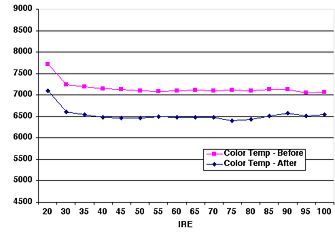
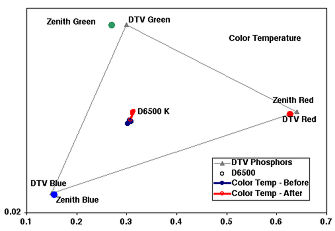
The top chart shows the gray scale of the C34W23 HDTV as set by the manufacturer in the most accurate color-temperature menu setting. The set measures 7,200 Kelvin across most of the range, increasing to 7,700 K with extremely dark images. After making adjustments using the Photo Research PR-650, the gray scale measures within 100 degrees of D6500, the accurate setting, across most of the range, drifting upwards to 7,100 K with extremely dark images. The bottom chart shows that the primary colors of the display's CRTs are reasonably close to those specified by SMPTE. This means that the display will accurately reproduce most of the colors available in the system. The gray scale measures only mildly blue before calibration and is more accurate afterward. The light output was approximately 31 foot-lamberts. The display has mediocre DC restoration before calibration and is more accurate afterward. The set's color decoder pushes red noticeably, and the set displays about 1,150 horizontal pixels with the 1080i test pattern from our Leader LT-446 HDTV test-pattern generator.—MW
